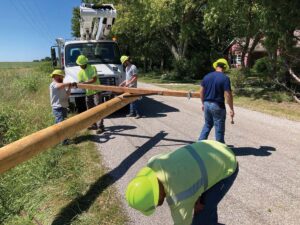America’s electric grid is often called the most complex machine in the world. That’s not a stretch when you think about what it does: it runs your refrigerator and charges your phone, all from a ray of sunshine, a lump of coal, falling water or a prairie breeze.
In between those starting and ending points are 160,000 miles of high-voltage transmission lines, millions of miles of low-voltage power lines, 7,300 power plants, nearly 200,000 electric utility employees, thousands of electrical substations and transformers that adjust voltage for the cross-country trip along transmission lines, then back down before it enters your house.
All these parts must work together to keep power flowing safely. In addition, this complex network is adapting to weather patterns, increasing cybersecurity threats, consumer expectations and additional decentralized power sources like rooftop solar panels.
Those are big changes for such a vast and intricate system, “but the silver lining is that technology is available to help address that,” says Venkat Banunarayanan, vice president of integrated grid business and technology strategies with the National Rural Electric Cooperative Association (NRECA).
For all its complexity, the electric grid can be described in three major parts: a power source (like a natural gas plant or wind turbine), the wires and equipment that deliver power, and a home or business that receives the power.
To understand the grid more, here are four ways it’s adapting to the world’s new realities.
Resilience in the face of more severe weather
Last year was the busiest recorded hurricane season along the Atlantic Coast. Wildfires are increasingly intense, especially in the west, and ice storms and cold weather surprised the South this winter.
These changes call for new ways to make sure the lights stay on.
Electric utilities are increasing grid resilience by integrating weather forecasting with other smart technologies that monitor electric current and analyze how to respond. NRECA’s Banunarayanan calls this “predictive technology.”
By knowing how weather will affect power equipment, he says, “An electric co-op can preposition work crews so they can quickly respond to the outage and redirect the flow of electricity to take an alternate route to minimize the duration of a power outage.”
Strengthening cyber safety
Cybersecurity measures have become standard operating procedure for utilities to protect against cyber attacks. Electric co-ops and other utilities work closely with the U.S. Department of Homeland Security to monitor and strengthen defenses.
Banunarayanan says, “Utilities are constantly improving to make sure they are more cyber-resilient.”
Electric co-ops also urge consumer-members at home to protect themselves from hackers. When devices like printers and smart TVs connect to the internet, that actually makes them part of the electric grid.
More power to consumers
Many utilities have voluntary programs that manage electric loads by turning off water heaters or air conditioners for short periods of time. Those programs add another layer of coordination. Additionally, homeowners are installing solar panels on their roofs or in their backyards, with some even selling excess electricity back to the utility—over the electric grid.
Utilities keeping up with the change
Large fields of wind turbine farms and solar power arrays require building transmission lines to new locations, and planning for power that might only operate when the sun shines or the wind blows. These changes are necessary and helpful, but also expensive.
Annual spending on the U.S. transmission system has increased from $9 billion a year in 2002 to $40 billion in 2019.
But that spending is paying off.
In 2017, Americans experienced about eight hours of power interruptions, according to the Energy Information Administration. By 2019, that was down to five hours.
“Power outages have been going down because there’s investment being made to increase the robustness of the grid,” says Banunarayanan. “I expect the reliability of the grid to increase.”









